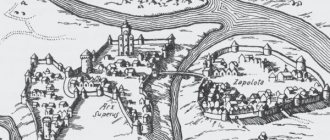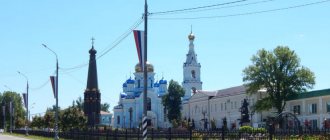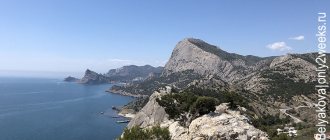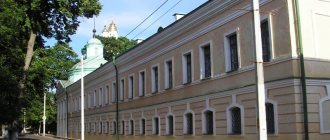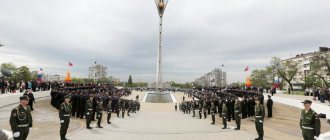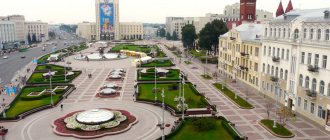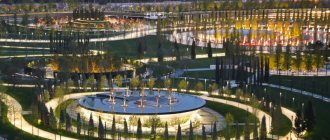Polotsk awaits tourists from Belarus who decide to go to the Vitebsk region. Its sights will tell and clearly show why the oldest city of the Republic is interesting, first mentioned in 862 in the “Tale of Bygone Years” and stretching along both banks of the Western Dvina, near the place where the Palata River flows into it. During its thousand-year life, Polotsk has seen a lot: paganism, chivalry, peaceful times and years of bloody battles. What is the first thing to see in it?
Polotsk: TOP-3 places worth seeing in 1 day
All newly arrived tourists are confused by the countless attractions of Polotsk. Where to start? This section contains the most interesting places in the city that you can easily see in one day.
Cathedral of Sophia the Wisdom of God
- Address: Lenin Avenue.
St. Sophia Cathedral was built in 1060 and became the first stone building in the country. However, the original Byzantine building has not survived to this day. In the second half of the 18th century, the exterior and interior layout were significantly changed by the architect Johann Glaubitz, who endowed the building with Vilna Baroque features.
This is exactly how he appears to us today: majestic and graceful. On both sides of the main building rise multi-tiered bell towers topped with emerald-colored domes.
In 1705, Peter I visited the cathedral. Or rather, he did not visit, but drunkenly invaded the shrine in the company of soldiers. When the emperor demanded that he be given the keys to the royal gates, behind which the relics of Josaphat Kuntsevich were kept, church officials refused him. Then the angry king personally killed the abbot and several monks, and ordered their bodies to be thrown into the Dvina.
This incident provoked the closure of the cathedral. A gunpowder warehouse was placed in its basements, which exploded in the spring of 1710. The half-destroyed church lay in ruins for 20 years and was restored in 1738.
The cathedral was active until the 1920s, when persecution of believers began and most religious buildings were closed. For a long time, the Local History Museum operated in the premises of the church. Liturgical activities resumed in 1983 after a large-scale restoration. Nowadays, divine services are regularly held here, and a museum dedicated to the history of the cathedral has been opened.
Museum of Medieval Knighthood
- Address: st. Engelsa, 3.
The Museum of Medieval Chivalry is not very large, but it can surprise visitors with an impressive exhibition. Three exhibition halls present:
- Knight armour,
- weapons (bows, spears, swords, shields),
- items of medieval life.
The premises are decorated in the style of stone castles with stained glass windows and torch lamps. For those who don’t mind tickling their nerves, there is a “Torture Chamber” - a basement room where the instruments of execution are stored - the rack, the “Spanish boot”, the “pear of suffering”, the “crocodile pipe” and others. On the tour you will be told how these instruments were used in the cruel medieval era.
Memorial sign “Polotsk - the geographical center of Europe”
- Address: Francysk Skaryna Avenue.
In 2008, Belarusian geodesists calculated the geographical center of Europe. The identified coordinates - 55o30′ north latitude and 28o48′ east longitude - showed that it is located on the territory of Polotsk.
In honor of this event, a memorial sign depicting a map of Europe appeared on Francysk Skaryna Avenue. A hemisphere rises above it, in the center of which there is a golden boat - the symbol of Polotsk. At the foot of the composition you can see four arrows - a compass indicating the cardinal directions.
What to bring
Polotsk is a beautiful ancient city with historical and religious sites. Mostly, tourists come to visit the famous St. Sophia Cathedral and the convent. After a trip, everyone wants to preserve the memory of their trip.
Souvenirs that reflect the essence of the city and country will be a great help with this:
- Church products can be purchased in cathedrals and churches.
- Many stores sell items with symbols of the country or the city itself.
- Natural sweets from local confectionery factories (Kommunarka, Spartak, Krasny Pishevik).
- Beautiful linen products, distinguished by their original design and durability (bed linen, clothing, tablecloths).
- Many tourists prefer to buy high quality meat and sausage products.
- Belarusian textiles and knitwear attract visitors to the country.
- Products made by local craftsmen from straw, wood and clay.
- In stores, everyone can buy inexpensive but high-quality Belarusian cosmetics (Belkosmex, Belita-Vitex, Markell).
Polotsk is a city with a rich history. By visiting attractions and unique places, tourists will be able to gain a deeper understanding of cultural and architectural features.
Article design: Oleg Lozinsky
The most interesting museums in Polotsk
Museums are the pride and heritage of Polotsk. They preserve evidence of past centuries and reflect the cultural characteristics and values of the city.
Museum of Local Lore
- Address: Lenin street, 11.
The oldest museum in Polotsk was founded in 1926. Its initial exhibition was located in the closed and converted St. Sophia Cathedral, and later moved to the building of the former Lutheran Church - a red-brick building in the neo-Gothic style, erected in the second half of the 18th century. It is easily recognized by its pointed towers and high spire.
The Great Patriotic War caused serious damage to the museum collection: ancient manuscripts, a valuable library and a collection of weapons were destroyed. The modern exhibition is based on surviving exhibits. It has more than two thousand storage units. Today there are several permanent exhibitions:
- “Archaeology” is an archaeological exhibition displaying artifacts of the Neolithic era - tools and protection, ceramics, amulets made from animal bones, stone figurines.
- "History of the Patriotic War of 1812." Here are collected relics of the war mentioned in the title - original uniforms, samples of weapons, banners.
- “Corner of a Belarusian hut of the 19th-20th centuries.” The exhibition is dedicated to ethnography and illustrates the life of Belarusian peasants.
The museum's archives also contain photographs, historical papers, ancient coins and rare books.
Natural and Ecological Museum
- Address: st. Francysk Skaryna, 21.
The museum was founded in September 2005. It was located in the premises of a disused water tower. In Soviet times, the 32-meter structure provided the city with water, but now serves as a storage facility for thousands of natural exhibits.
The museum consists of four levels, the communication of which is carried out using a glass staircase symbolizing the Tree of Life:
- The first level is called “Belarus is our home.” It is dedicated to the biological diversity and unique nature of the country.
- At the second level - “Given to Civilization” - tourists will get acquainted with the problems of environmental pollution in modern cities, including Polotsk.
- The third level is called “Protected territories”. Here the story will be about protected areas, endangered species and the preservation of natural monuments.
- The fourth level is a conference room where lectures and film screenings are held. There is also an observation deck here, which offers an impressive view of the city panorama.
Museum of Belarusian Printing
- Address: st. Lenina, 22.
The institution is located in the building of a former monastery school, which belonged to the Epiphany Orthodox monastery. The white stone structure of the 18th century is protected as a historical and architectural monument. The museum began functioning in the fall of 1990. Its opening was timed to coincide with the celebration of the 500th anniversary of the birth of the Belarusian pioneer printer of the 16th century, Francis Skaryna.
The attraction's exhibitions demonstrate the evolution of books, from ancient scrolls to modern editions. During the tour, visitors get acquainted with the history of writing, the improvement of stationery, and the technology of printing and binding books.
The exhibition occupies 15 halls and includes more than 2,500 exhibits, as well as an extensive library of Belarusian literature. At the exit from the museum, there is a souvenir shop where you can independently buy art and scientific books, rare newspapers and magazines, gift cards and calendars.
Children's Museum
- Address: Nizhne-Pokrovskaya, 46.
The children's museum is located in a small house located in the middle of a flower garden. At the entrance, guests are greeted by bronze figures: “Girl with a Clock” and “Schoolboy”. The exhibition is divided into several halls:
- The “Hall of Inventions” introduces little excursionists to such devices as a camera, scales, a samovar, and a bell. Children are allowed to pick up objects, press buttons and look at them in any way they want. The purpose of the interactive excursion is to help children understand the essence of the inventor’s profession. Portraits of famous scientists are hung on the walls of the hall so that children can see the faces of engineering geniuses.
- "Children's room". There is a comfortable and even playful atmosphere here. Children's books and toys are scattered throughout. In this room, educational quizzes, educational games and exciting quests are organized.
- "Collections of small residents of Polotsk." The exhibition was created through the efforts of the city's children's population. The display cases display badges, stamps and toys that young residents of Polotsk donated to the museum. The collection is constantly updated, and anyone can contribute.
Where to go with a child
Polotsk is a small city where there are not many places where you can go with your children to have fun:
- Children's Museum (Nizhne-Pokrovskaya St., 46). In the museum, children will be able to explore the world around them through objects. There is a collection of toys from different periods here. Children will be able to touch many inventions with their hands and take a closer look.
- Game labyrinth Bi-BiGon (shopping center "Manezh", Vilniusskoe highway, 1). At the play center, children can jump on trampolines and go through mazes. There are various children's gaming machines here. A climbing wall and rope park have been created for active children and adults.
- Park of Culture and Recreation (near Nizhne-Pokrovskaya St., 52). There are attractions in the park during warm weather. Parents will be able to relax on benches in the shade of trees. On the territory of the park there is a fountain and various cafes and stalls with souvenirs and toys.
Religious objects and Polotsk churches
Religious institutions and shrines of Polotsk come from ancient eras, belong to different architectural styles, but have a common spiritual and educational goal.
Spaso-Euphrosinievsky Monastery
- Address: st. Euphrosyne of Polotsk, 89.
This convent is the oldest and largest Orthodox center in all of Belarus. The monastery was founded in 1125 on the initiative of Princess Euphrosyne of Polotsk.
The single-domed Church of the Transfiguration of the Savior is recognized as its most significant building. It is an impeccably preserved example of ancient Polotsk architecture. On the territory of the monastery there are also:
- Holy Cross Cathedral,
- belfry,
- refectory church,
- cells and chapels.
All buildings are made of white stone in the neo-Byzantine style and were built between the 12th and 19th centuries.
For a long time, the main relic of the monastery was considered the Cross of Euphrosyne of Polotsk - a precious altar crucifix with particles of the Sepulcher and the Cross of the Lord. After the monastery was closed in 1921, the relic was transported to Minsk and lost in 1941 during the German occupation.
The cross has not been found to this day, but in the late 1990s. Brest jeweler Nikolai Kuzmich made a perfect copy of the jewelry, which is now exhibited in the Transfiguration Church in place of the missing shrine.
Church of the Intercession of the Blessed Virgin Mary
- Address: ave. Francysk Skaryna, 42.
The original wooden church was erected in 1781 as a cemetery church, but later acquired the status of a parish cathedral. In 1838, the Polotsk diocese decided to demolish the dilapidated church and build a new one in its place - a white stone one.
Architect M.I. Domakurov built a beautiful building in the neo-Byzantine style, decorating it with arched windows and figured masonry. The main building and the adjacent tented bell tower were crowned with golden domes.
The church served parishioners until 1930, when the Soviet government banned religious activities. The building remained abandoned for 14 years, and after the liberation of Polotsk from the occupiers in 1944, a chocolate factory opened in it.
In the 1960s There was a strong fire at the production facility that destroyed the building. It was restored in 1991, but no longer as a factory - the building was returned to its temple status. The Church of the Intercession was reconstructed and re-consecrated in 2004.
Borisov stone
- Coordinates on the map: 55.485717, 28.758072.
Borisov stones are massive boulders with carved crosses and typical inscriptions: “God, help your servant Boris.” According to the theory of historians, these blocks and boulders were created at the behest of Boris Davydovich, the ruler of the Polotsk lands in the 12th century.
The described specimen was discovered in the waters of the Western Dvina at the end of the 19th century, but it was only brought to land a century later. The 3-meter stone has a reddish color, uneven shape and rough surface. The carved cross and the inscription have been erased by time and are practically invisible. Borisov Stone is considered a shrine and spiritual heritage of the city.
Spaso-Efrosyne Monastery
This is the oldest and largest female Orthodox monastery in Belarus. It was founded in the 12th century by Princess Euphrosyne, when she and her sisters took monastic vows. Thanks to the nuns, a few years later a temple was built in the monastery.
After the capture of Polotsk by the troops of the Polish-Lithuanian Commonwealth, the monastery was given to the Jesuits, who owned it until the beginning of the 19th century. Later, the Jesuits were expelled from the city, and the monastery was transferred to the sovereign's treasury.
During the Soviet era, the monastery was closed and practically destroyed along with the churches. Today it has been restored, the monastery is active, nuns live here, tourists come here for educational excursions.
Unique architecture of Polotsk
The development of the city of Polotsk is impressive in its diversity. In addition to modern buildings, there are unique structures protected by the state as monuments of folk architecture.
College of the Jesuits
- Address: Streletskaya, 4.
The educational institution was founded in the distant 16th century by Prince of Lithuania Stefan Batory. The wooden building burned to the ground in 1740, and St. Stephen's Cathedral was erected in its place.
The Jesuit school was revived in 1750. Then a three-story stone building was built for his needs, which still stands today. Such outstanding personalities as
- Jan Cywinski (Catholic bishop),
- Valentiy-Wilhelm Vankovich (artist),
- Martin Poczobut-Odlanicki (Belarusian astronomer and mathematician).
On the territory of the college you can find many interesting attractions: bronze sculptures and monuments are installed along the alleys, there is an ancient clock in the courtyard, and there is an art gallery in one of the buildings.
House of Peter I
- Address: Nizhne-Pokrovskaya st., 33.
The small house was built in 1692 in the Baroque style. This is a one-story building in the shape of an irregular rectangle. Its façade is decorated with frequent windows with carved frames and figured cornices. The end is decorated with stucco, rosettes and an attic.
The house was built for Peter I, who lived in it in the summer of 1705 during the Northern War. In subsequent centuries, the building was rebuilt several times, but in the 1990s it was returned to its original appearance. Nowadays there is a museum here.
Fire Tower
- Address: Zamkovy Proezd.
The 33-meter fire tower appeared in 1927 and became the final element of the fire department building. At all times, Polotsk had predominantly squat buildings - even to this day, the only rival to the six-story tower in terms of height is St. Sophia Cathedral.
Despite the fact that the tower stands out against the background of low buildings, it is in perfect harmony with the overall architecture. Her formal style is enlivened by a pretty pink color scheme. The old fire station is still in operation today, but the tower is no longer used to detect fires. Now it plays an aesthetic role and often appears on souvenir postcards as one of the most recognizable buildings in the city.
How to get there
Polotsk is a major automobile hub in the Vitebsk region. Republican roads pass through its territory. There is a railway station in the city. By buses and trains you can travel not only to neighboring cities, but also to other regional centers and neighboring countries. Polotsk does not have its own airport, and the nearest one is in Minsk.
Tourists mainly come by their own car or use a train or bus:
| Kind of transport | Peculiarities |
| Air |
|
| Train |
|
| Bus |
|
| Automobile |
|
War memorials and monuments
Polotsk has survived many wars and does not forget its heroes, despite the unstoppable passage of time.
Mound of Immortality
- Address: st. Mound of Immortality, 1.
The mound was erected in 1966 in memory of the Polotsk residents who died in the battles of the Second World War. The peculiarity of the 10-meter embankment is that it contains soil from the sites of major battles and mass graves, as well as the ashes of villages burned by the Germans.
The architect of the attraction was N.P. Glazunov. He gave the ground a pyramidal shape and installed a bowl with the Eternal Flame on top. At the foot of the mound there is a memorial slab, at which there are always fresh wreaths.
Monument to the liberators of Polotsk
- Address: pl. Freedom.
The memorial is located on Freedom Square. It is a wall made of hewn stones with a bronze high relief of three Soviet soldiers holding a banner. The monument is dedicated to the Red Army soldiers of the First Baltic Front - the heroes who liberated Polotsk from the German occupiers on July 4, 1944. In front of the memorial there is a small platform on which the Eternal Flame is installed.
Red Bridge
- Address: Euphrosyne Polotskaya Street.
The bridge over the Palata River was named "Red" in honor of the battle that took place there in the fall of 1812. The battle between the Russian and French troops was so fierce that the wooden deck of the bridge was stained with blood.
In 1975, the battle site underwent restoration. The dilapidated wooden walkway was replaced with reinforced concrete, preserving the elements of the previous design. At the entrance you can see a memorial sign with a memorial inscription telling about the origins of the name of the building.
Monument to the heroes of the Patriotic War of 1812
- Address: pl. Freedom.
The monument rises in the center of Freedom Square. This is an impressive stele in the shape of a hexagonal pyramid, decorated with figured columns on the sides and topped with a dome with a golden cross on top.
It is located on the site of the original monument, which was erected in the mid-19th century. The opening ceremony took place in 1850, and was attended by Tsarevich Alexander Nikolaevich, the future Emperor Alexander II. The monument was demolished in 1930 and replaced with a statue of Lenin.
The monument to the heroes of the Patriotic War of 1812 was revived only in 2010. The updated stele completely repeats the architecture of its predecessor. On both sides of it there are models of guns used in the battles of that war.
Where to stay
Polotsk, whose attractions attract a large number of tourists, has several good hotels. In addition to hotels, city guests will be able to rent comfortable apartments and apartments.
For example:
- Bizon (Novopolotsk, Armeiskaya str., 69a). The hostel is located in a quiet and peaceful place. Guests have access to rooms with a private bathroom, small kitchen, internet and TV. The hostel has a cozy terrace. Tourists are accommodated in rooms for 2 people. The cost per day for 1 adult is from 1300 RUR. rub.
- Gostiny Dvor Polotsk (Shkolnaya st., 1a). The small hotel offers cozy rooms with private bathroom and TV, family rooms and suites. Guests can visit the restaurant, which serves European and Belarusian cuisine. The cost of a room with 2 beds starts from 1966 rubles.
- Sofia (Schmidt lane, 20). The hostel offers tourists suites and rooms for 2, 4 and 6 people with a shared bathroom. There is a playground for children outside. Guests can enjoy a small indoor pool and a shared sauna. The cost of a place in a room for 6 people is 590 rubles.
The main monuments and sculptures in Polotsk
The streets, squares and gardens of Polotsk are decorated with the works of talented sculptors. These works are not as great as architectural monuments, but nevertheless they contribute to the appearance of the city, giving it individuality.
Monument to Prince Vseslav the Magician
- Address: corner of Oktyabrskaya and Evfrosinya Polotskaya streets.
Vseslav Bryachislavovich - Prince of Polotsk, who ruled in the 11th century. He was nicknamed “The Sorcerer” because he always seemed to the people to be a mysterious and even mystical person. The monument to the legendary ruler was erected in the fall of 2007.
Minsk resident Alexander Prokhorov acted as the main sculptor. He depicted the prince galloping on a mighty horse. Vseslav is dressed in princely attire, and behind his shoulders is a cloak of wolf skin. The sculpture became the first equestrian composition on the territory of Belarus.
Monument to Euphrosyne of Polotsk
- Address: corner of Kommunisticheskaya and Euphrosyne Polotskaya streets.
Euphrosyne of Polotsk was the granddaughter of Vseslav Bryachislovovich and went down in the history of Belarus as a benefactor who built several churches at her own expense. After her death, she was canonized.
A monument to the devout woman appeared in Polotsk in the fall of 2000. The famous sculptor Igor Golubev depicted Euphrosyne in a church cassock flowing to the steps and holding a cross in her hand. Subsequently, copies of this sculpture were installed in many cities of Belarus.
Monument to Simeon of Polotsk
- Address: Engels street, 8.
In 1629, the future writer, theologian and scientist Samuil Gavrilovich Petrovsky-Sitnyanovich was born in Polotsk. He received the nickname “Polotsk” in gratitude for his contribution to the development and education of the city.
Upon completion of his education, Simeon took monastic vows and devoted his life to worship. His sermons were attended by the family of Prince Alexei Mikhailovich Romanov, and Princess Sophia called Polotsk her spiritual mentor.
The monument to such an outstanding personality was erected in 2003. The opening ceremony was timed to coincide with the Day of Belarusian Literature. Cast in bronze, the elder appears before the viewer in monastic vestments, leaning on a music stand, where sheets of paper with a prepared sermon lie.
Monument to the Krivichs
- Address: st. Streletskaya, 4.
Krivichi are East Slavic tribes considered the founders of Polotsk. The composition of Alexander Shaternik’s work is dedicated to them. The Art Nouveau sculpture depicts a boat ruled by Princess Rogneda and her son Izyaslav. They are accompanied by warriors, ready to rush into battle at any second, protecting their masters.
Rogneda, the wife of Prince Vladimir, tried to stab her husband while he was sleeping. The woman was driven by a thirst for revenge because he forcibly took her as his wife, having previously killed her entire family. But the prince woke up and managed to dodge the fatal blow. After this, Rogneda and Izyaslav, who protected their mother from their father’s rage, were exiled to Polotsk, where the boy became the founder of the Polotsk branch of princes.
Monument to the letter "Ў"
- Address: Francysk Skaryna Avenue.
The letter “Ў” is a symbol of the Belarusian alphabet and a truly unique letter, the like of which is not found in any language in the world. The sound it denotes makes Belarusian speech soft and melodic. The bronze monument to the letter “Ў” was unveiled in 2003 in honor of the Day of Belarusian Literature. It is made in the form of a book, on the cover of which are written words starting with this letter.
Travel tips
When visiting the cities of Belarus, including Polotsk, follow certain rules that will help you avoid unpleasant moments during your vacation:
- name the country correctly. Many visitors pronounce "Belorussia", and some locals do not like it. The official name of the country is “Belarus”;
- do not smoke in public places, and do not drink alcoholic beverages, including beer. The list of prohibited places includes balconies of houses and hotels;
- do not leave minor children unattended on the city streets after 23.00;
- Park your car only in permitted places, otherwise your car may end up in a parking lot in a short time;
- do not photograph train stations, government buildings, or military installations.
Attractions in the vicinity of Polotsk
After a long walk around the city, it’s nice to relax in nature. From the final paragraph of this article you will learn about the best green corners of Polotsk and its surroundings.
City beach on the Dvina
- GPS coordinates: 55.482824, 28.775096.
In the summer, the swimming season opens in Polotsk, and as a result, all those who like to splash in the pleasant, cool water go to the beach. The bank of the Dvina is well equipped - there are parking lots, sun loungers, changing cabins and dry closets.
The area is kept clean: walking dogs, littering and lighting fires is prohibited near the river. The bank is grassy, the river bottom is sandy, sometimes there are small stones. Swimming here is completely safe, but just in case there is a lifeguard station near the river.
Lake Lyukhovo
- Coordinates: 55.517735, 28.617091.
The lake is located 10 km from Polotsk and belongs to the Western Dvina basin. The depth of the reservoir reaches 20 meters, closer to the shore it decreases to 4 meters. Sometimes there is shallow water on the lake.
A large number of fish live here, especially perch, pike, bream and tench, which makes the lake attractive to fishermen. The banks are low and wooded. The local pine forest is rich in nuts, berries and mushrooms.
Serdovo Lake
- Coordinates on the map: 55.404489, 28.434347.
Serdovo Lake is one of the most picturesque places in the Polotsk region. The area of the reservoir is 1.1 km2, and the depth reaches 9 m. The bottom is muddy, the underwater vegetation is not wild - the lake is ideal for swimming and rowing boats.
Fishing lovers will also have something to do: local waters abound with roach, pike, bream and even crayfish, which indicates cleanliness. Flowering meadows stretch along the banks, where it’s nice to take a walk with your family and stop for a cozy picnic in nature.
Distinctive features of the city
Many scientists believe that the center of the European part of the continent is located in Polotsk. This is served by a memorial sign installed at the required coordinates. The Hagia Sophia hosts cultural events and concerts with an organ and orchestra.
Climate
Polotsk lies in the north of the republic and is influenced by the Atlantic-continental climate. The coldest month is January. Temperatures at this time of year can drop to -20 degrees.
Winter is changeable. Frosts give way to thaws. The warmest weather occurs in July, when the thermometer rises to an average of +27 during the day and +15 at night. There is also precipitation at this time of year.
Ecology
There are several large industrial enterprises in Polotsk that produce fiberglass and foundry products. The factories have installed technologies that monitor emissions into the atmosphere. There are several food industry enterprises. The city is located in the Polotsk lowland. The Western Dvina and Polota flow through the city.
Population
On an area of 40.8 sq. km are home to almost 85 thousand people. 6 km from Polotsk on the other bank of the Western Dvina, Novopolotsk was formed with a population of almost 102 thousand people.
Among the outstanding personalities who were born or lived in Polotsk, the following stand out:
- Simeon of Polotsk wrote independently and translated many works. He taught the children of Tsar Alexei Mikhailovich.
- Euphrosyne of Polotsk is a Belarusian Saint who founded a convent in Polotsk.
- Vseslav the Magician is a Polotsk prince, under whose reign the construction of St. Sophia Cathedral began. Vseslav is mentioned in the Tale of Igor's Campaign.
- Francysk Skaryna is a pioneer printer. He translated the Bible into Belarusian.
The city was home to 10 Heroes of the USSR and 4 citizens who were awarded the title of Heroes of Socialist Labor.
Jesuit school
Ancient Polotsk is not only the center of Europe, Orthodoxy and Catholicism, Russia and the Polish-Lithuanian Commonwealth came into close contact here. A striking example of the clash of cultures is the Jesuit college, which appeared in the city in the 16th century.
In the 18th century, the activities of the Catholic Jesuit order were banned in Europe, and in Russia they were treated with indifference. Therefore, the college, which had previously slumbered in oblivion in Polotsk, flourished in full force at the end of the 18th century.
They provided a very good education here, because... Jesuit scholars from all over Europe came to the school. Therefore, Emperor Alexander I ordered to organize an academy on the basis of the collegium. Today the faculty of Polotsk University is located here.
